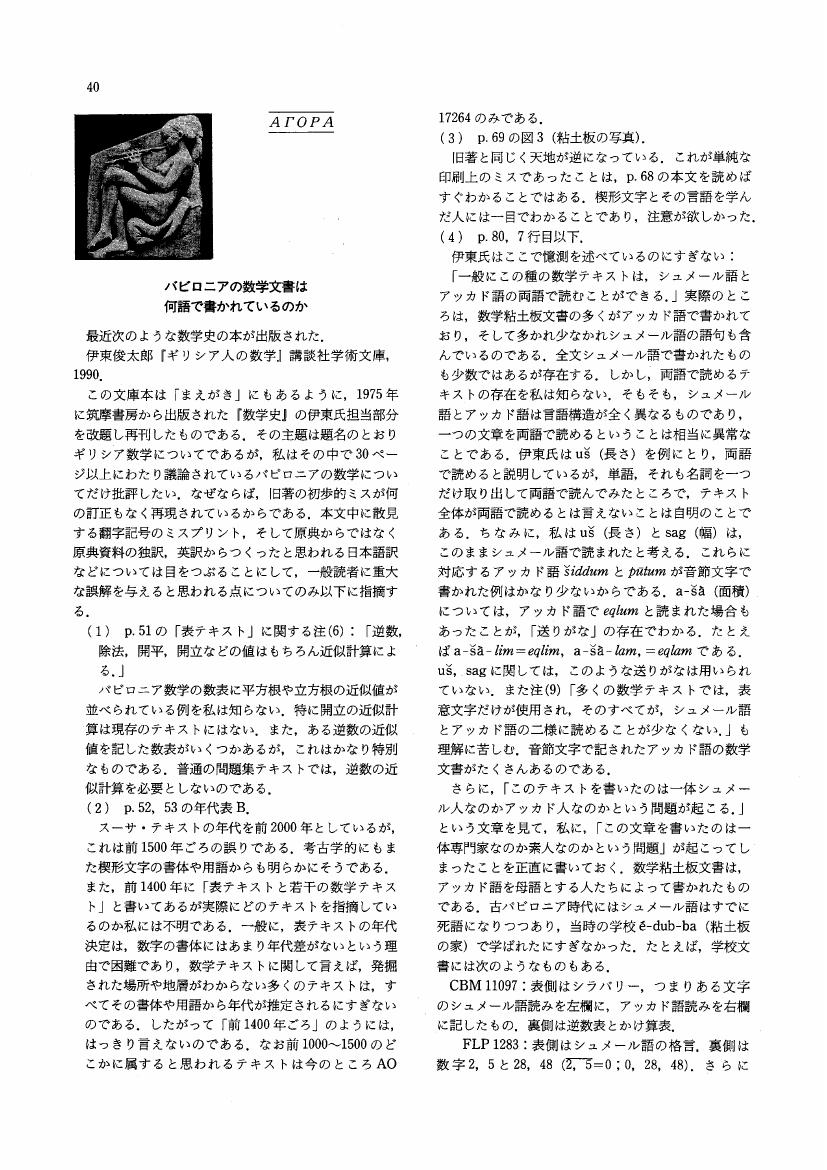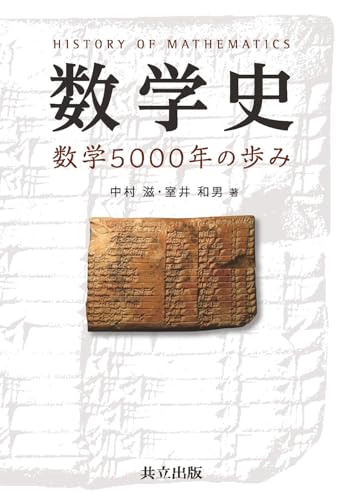1 0 0 0 OA セレウコス朝時代のある逆数表の奥付けについて
- 著者
- 室井 和男
- 出版者
- 日本科学史学会
- 雑誌
- 科学史研究 (ISSN:21887535)
- 巻号頁・発行日
- vol.32, no.185, pp.29-31, 1993 (Released:2021-03-23)
1 0 0 0 OA バビロニアの文学作品に表れている数学の術語について
- 著者
- 室井 和男
- 出版者
- 日本科学史学会
- 雑誌
- 科学史研究 (ISSN:21887535)
- 巻号頁・発行日
- vol.31, no.182, pp.99-102, 1992 (Released:2021-04-03)
1 0 0 0 OA バビロニアの数学文書は何語で書かれているのか(アゴラ)
- 著者
- 室井 和男
- 出版者
- 日本科学史学会
- 雑誌
- 科学史研究 (ISSN:21887535)
- 巻号頁・発行日
- vol.30, no.177, pp.40-41, 1991 (Released:2021-08-30)
1 0 0 0 OA バビロニア数学の"壁に立てかけられた棒"に関する2つの問題について
- 著者
- 室井 和男
- 出版者
- 日本科学史学会
- 雑誌
- 科学史研究 (ISSN:21887535)
- 巻号頁・発行日
- vol.30, no.177, pp.23-27, 1991 (Released:2021-08-30)
1 0 0 0 OA バビロニア数学粘土板A06770の再検討と新解釈の提出
- 著者
- 室井 和男
- 出版者
- 日本科学史学会
- 雑誌
- 科学史研究 (ISSN:21887535)
- 巻号頁・発行日
- vol.26, no.162, pp.103-108, 1987 (Released:2021-09-21)
AO 6770 is a very important text which treats the calculation of a compound interest among others. Many scholars have tried to make clear the mathematical meaning of the text, but in my opinion none have completely succeeded in doing so. I reexamined the text philologically and mathematically, and have arrived at the following conclusions. 1. The line 1 of the problem No.1 reads "Length and width. One (ma-la) iku. Be it (sag) a square number." The Babylonian solved this problem by transforming a square the sides of which are 10 ninda into a rectangle retaining the same area the width of which is 4 ninda. He presupposed that the answer would be 4, and confirmed it by demonstrating that the length was given in an integer through the calculation of 0;15 * 1,40. 2. Thureau-Dangin and Neugebauer's interpretation of the problem No.2 is fundamentally right. It is certain that the transformation of units in the answer was carried out, so to speak, automatically, because the rate of the compound interest was 20%. And also in the lines 13-17 we can see the special form of division which is generally used when the divisor is a so-called "irregular number", though the divisor 1;12³ in this case is not an irregular number. 3. The problem No. 3 treats a linear equation which is formulated correctly by Thureau-Dangin (though his explanation of the process of the calculation is erroneous). I translate "šapiltum"as "a result of a calculation", that is, I translate it in the line 7 as 0; 55 which is one result of an addition but not its sum, and in the line 9 as 6 which is a result of a subtracion, namely a remainder.In the lines 6, 7 the Babylonian conducted a complicated calculation of "šu-nigin" which is the weight subtracted from the initial weight"abnum" and in the remaining lines he got the "rēš abnīya" as the final answer from the šu-nigin.
1 0 0 0 OA バビロニア数学における容量単位silàの特殊用法とVAT8522の解釈について
- 著者
- 室井 和男
- 出版者
- 日本科学史学会
- 雑誌
- 科学史研究 (ISSN:21887535)
- 巻号頁・発行日
- vol.25, no.160, pp.261-266, 1986 (Released:2021-09-22)
A Babylonian capacity unit "silà" was also used as a unit of "thickness" of a log. Neugebauer and Sachs almost clarified the meaning of the silà through a study of YBC 4669, 8600, that is, "x silà of a log" means a capacity of a circular cylinder whose height is 6 šu-si But the contents of VAT 8522 Vs.I which treats the thickness of a log remains obscure despite their efforts. I find a clue to the solution to the calculation in VAT 8522 Vs.I in the expression of relation 1 silà=(6 šu-si)³=(0;l ninda)³ and the number 1;20 which is hidden in line (6a) of the text. Neugebauer suggested that 1;20 was a "normalizing constant" and I regard this as a proportional constant between the area of a square and the area of its inscribed circle in case of a certain equivalent transformation of a prism into a circular cylinder The process of the calculation made by a Babylonian scribe in a roundabout way is as follows. In the first place he takes the cubic roots of 1,4 silà and 8 silà, and gets 4 dal,2 dal respectively (unit; 6 šu-si). Namely he transforms each circular cylinder into a cube retaining the same volume. Consequently "dal" is a side of the cube and not a diameter here. Next after taking the average of the dais, an assumed circular cylinder which is inscribed in the averaged cube is introduced and the area its base is calculated by a usual formula. This "whole area" is multiplied by 6,40 ( = 5,0 * 1;20) to get the true volume. At this point Babylonian "normalization of a log" has been completed. The last calculation, which is omitted in the text is, in my judgement, as follows. By dividing the volume by the area of the base of the normalized log, the length of the log is obtained, and then by multiplying it by 9/10 the length of the log which should be cut down is obtained.
1 0 0 0 OA 数学粘土板VAT672の一所見
- 著者
- 室井 和男
- 出版者
- 日本科学史学会
- 雑誌
- 科学史研究 (ISSN:21887535)
- 巻号頁・発行日
- vol.25, no.159, pp.151-154, 1986 (Released:2021-04-05)
- 著者
- 室井 和男
- 出版者
- 日本科学史学会
- 雑誌
- 科学史研究 (ISSN:21887535)
- 巻号頁・発行日
- vol.25, no.157, pp.50-52, 1986 (Released:2021-04-05)
1 0 0 0 OA バビロニアの幾何学-2,3の未解決問題について
- 著者
- 室井 和男
- 出版者
- 日本科学史学会
- 雑誌
- 科学史研究 (ISSN:21887535)
- 巻号頁・発行日
- vol.24, no.156, pp.231-235, 1985 (Released:2021-04-05)
1 0 0 0 OA バビロニアの数学 : 楔形文字で書かれた古代数学 (数学史の研究)
- 著者
- 室井 和男
- 出版者
- 京都大学数理解析研究所
- 雑誌
- 数理解析研究所講究録 (ISSN:18802818)
- 巻号頁・発行日
- vol.1064, pp.160-171, 1998-10
1 0 0 0 IR バビロニアの数学 : 楔形文字で書かれた古代数学 (数学史の研究)
- 著者
- 室井 和男
- 出版者
- 京都大学
- 雑誌
- 数理解析研究所講究録 (ISSN:18802818)
- 巻号頁・発行日
- vol.1064, pp.160-171, 1998-10








